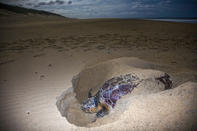An Ancient Nesting Ritual
The coastline of the iSimangaliso Wetland Park near Cape Vidal, is the only remaining major nesting site in Africa where loggerhead and leatherback turtles still lay their eggs.

This ancient nesting ritual starts early in November every year; the female searches for a suitable site above the high-water mark where she then digs a nest, down to 1 m in depth, and lays a batch of 80 - 100 eggs before carefully closing the nest and concealing its presence from foragers like jackals, genets, honey badgers and ghost crabs.
The eggs can take up to 70 days to hatch, and from January through to March the hatchlings emerge at night and make their way to the sea. It is estimated that only about four out of 1,000 hatchlings reach maturity. Recent evidence suggests that the females will return to lay their eggs on the beaches where they hatched; how they find their way back remains a mystery.
Join a St Lucia Turtle Tour (operating from St Lucia and Cape Vidal from November to March) and watch this ancient nesting ritual, also one of nature’s most amazing circles of life. It is truly a magical and life-changing experience, and seeing it in the company of a knowledgeable and very experienced guide is even better.
South Africa's Finest Birding

The birdlife at Cape Vidal is prolific, offering some of South Africa’s finest birding. The unspoiled beaches, fascinating wetlands, dense coastal forests and Lake Bhangazi’s shores are home to 526 bird species and the Catalina Bay lookout point is a particularly rewarding spot for birders.
Specials include both white and pink-backed pelicans, rufous-bellied heron, saddle-billed and yellow-billed storks, lesser and greater flamingos, southern banded snake eagle, crested guineafowl, buff-spotted flufftail, lesser jacana, Caspian tern, Livingstone’s turaco, green coucal, mangrove kingfisher, African broadbill, yellow-spotted nicator, white-throated, brown and bearded robins, Rudd’s apalis, Woodward’s batis, short-tailed pipit, pink-throated longclaw, gorgeous bush shrike, Neergaard’s sunbird, green and pink-throated twinspots, and grey waxbill.